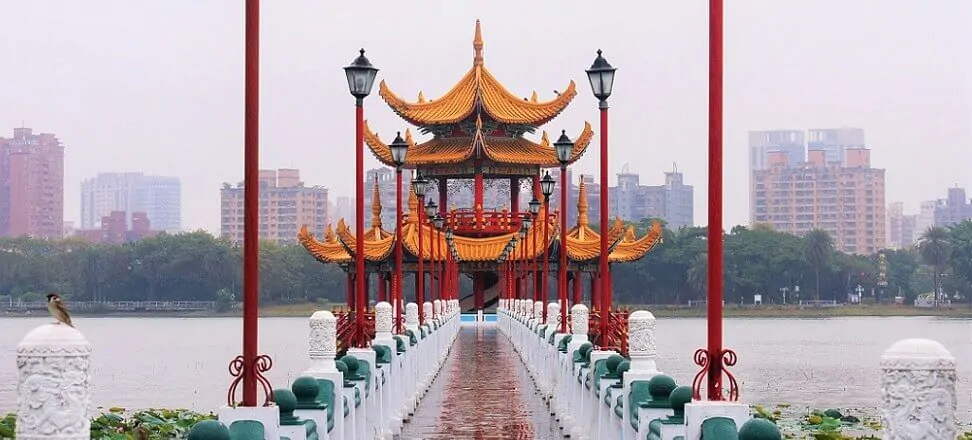Business and economics, Issue 14/2024
Taiwan’s economy dries up – a threat to global semiconductor production
Two new seawater desalination plants are expected to support Taiwan’s people and economy in the coming years. The prolonged drought meant that this spring there was only 30-60 percent of the average water level in the country’s reservoirs. Introduced in the fall of 2023. The resource conservation program has admittedly reduced water consumption by 840 millioncubic meters, but this is just a drop in the ocean of needs.
Water situation in Taiwan
That Taiwan, which is one of the rainiest places in the developed world, is facing water shortages is a paradox bordering on tragedy, says a report on the drought that hit the island nation in 2021/2022. The average annual precipitation here is actually 2,600 mm, but 70 percent. of which are provided by rains occurring during the typhoon season, which in Taiwan runs from June to October. When in 2021. for the first time in 56 years, the rainy season has failed, the country’s water resources have fallen to just 5 percent. total size. The shortage has hit Taiwan’s citizens and economy hard.
Hydrological risks are primarily blamed on climate change, which disrupts nature’s natural water cycle. The drought of the century, as the unprecedented shortage of rainfall 3 years ago was called, prompted the Taiwanese government to prepare a water management plan for each region of the country. It aims to ensure a stable supply of water as part of better catchment management, the development of a supra-regional transmission network and improved water production based on new technologies. The plan is to be implemented by 2036.
Alternative water sources that can benefit Taiwan’s society and economy are identified as:
- water from the hyporeic zone, which can be treated by filtration through gravel;
- Development of seawater desalination plants;
- recycling gray water from households.
Since 1989. In Taiwan, 24 seawater desalination plants have been built in Penghu, Kinmen and Matsu, which together provide 43,000m3 of water per day. Investments are now being planned that will spectacularly increase this potential.

SUEZ to build plant in Hsinchu City
France’s SUEZ Group, a global water and wastewater giant, in cooperation with Taiwanese companies, CTCI Group and Hung Hua, will launch a new water and wastewater treatment plant in July. construction of a giant desalination plant in Hsinchu City. The project is expected to be completed in 2028 and will supply 100,000m3 of water per day. The entire project is worth 508 million euros.
Desalination at the new plant will be carried out by reverse osmosis. SUEZ, as part of the signed contract, will operate and maintain the installation powered by photovoltaic panels for the next 15 years. The investment is based on the principle of minimizing the use of space, construction materials and carbon footprint. In addition, a pigging system will be used to clean offshore water pipes, which reduces the amount of wastewater produced.
According to Taiwan’s Water Resources Agency (WRA), the project in Hsinchu City is groundbreaking because it uses cooperation with a foreign technology provider for the first time. Its implementation will benefit not only the public, but also Taiwan’s economy, particularly the semiconductor manufacturing sector that includes many factories in the Hsinchu Science Park.
Desalination of seawater also in Tainan
A second project, on an even larger scale, is being prepared by Spain’s Coxabengoa, one of the world’s largest desalination giants. The company has won the tender for the first phase of the plant located in Tainan city. Ultimately, it will be the largest seawater desalination plant in Taiwan with a daily production of 200,000m3. It will provide drinking water for the island’s 1 million residents. In this case, the contract covers the construction of a desalination plant and its management for the next 15 years. The investment will employ 200 people.
Recall that Coxabengoa is also involved in the construction of the largest seawater desalination plant in the world – the Tawelaah complex located in the United Arab Emirates, 50 km from Abu Dhabi. The local daily production potential is estimated at 909, 000m3.
Taiwan’s economy needs water
Water demand in Taiwan is not just a matter of meeting the consumption needs of more than 9 million households. Desalination is expected to benefit first and foremost Taiwan’s buoyant economy, particularly the two sectors most dependent on water supply – agriculture and the aforementioned semiconductor manufacturing.
Although officially agricultural production accounts for only 1.5 percent of Taiwan’s GDP, analyses considering the full value chain say as much as 10-11 percent. GDP share. Of this, the dominant role is played by the extremely water-intensive rice crop, which occupies as much as 20 percent. The territory of the entire country. During the 2021 drought period. The government was forced to impose such drastic restrictions that the 74 thousand. ha Rice fields have been cut off from irrigation. Destroyed crops were sold at heavily discounted prices for feed. Crops of corn, soybeans, buckwheat, peanuts and vegetables have also suffered. Farmers thus lost out to the electronics sector.
Despite widespread water restrictions, Taiwan’s government has decided to support the profitable Taiwan Semiconductor Manufacturing Company (TSCM), which produces 25 percent of the country’s water. Of all semiconductors in the world, and 92 percent. The most advanced chips used, among others. in smartphones and artificial intelligence installed in cars.
Why does the electronics industry need water? The production of semiconductors requires the use of so-called. ultrapure water (UPW) in the oxidation phase so that the oxide layer deposited on the silicon wafer is of the highest possible quality. Water is also used in the photolithography stage, i.e. when reproducing patterns on a semiconductor substrate. Meanwhile, to produce 1,000. Liters of UPW need to consume about 1.4-1.6 thousand. Liters of water from the water supply. As a result, a large semiconductor factory producing 40,000. Silicon wafers per month use as much water per day as a city with a population of 60,000. in a year!
What does the future hold for Taiwan?
So far, Taiwan’s economy is doing well mainly through discipline. Its effects, however, are severe for the public and farmers. As part of the 2020 introduced. restrictions in the country’s second largest city, Taichung, households were completely cut off from water for two days a week. Low water levels in the rivers have also taken a toll on the productivity of hydroelectric power plants – in May 2021. There have been two major power outages.
Unfortunately, the outlook is not optimistic. According to forecasts presented in the aforementioned drought report, by the end of this century the amount of precipitation feeding reservoirs could decrease by 25 percent in the north of the country and 50 percent in the south. It doesn’t help that the current infrastructure is in poor condition – the level of water loss in the water supply network in 2020. was as high as 13.9 percent. Rice field irrigation systems date back to the Japanese colonial era, and only ¼ of the water sent through them reaches the crops.
It is only in recent years that the government has begun to realize that Taiwan’s economy will collapse without water, and its availability is steadily declining. In addition to building desalination plants, the proposed remedial steps also include restoring aquatic and forest ecosystems, introducing more drought-tolerant rice varieties and upgrading field irrigation technology. Private companies in the agricultural sector are also investing in artificial intelligence to enable more efficient crop management. The need to raise water prices, which are currently the lowest in all of Asia, is also anticipated – it is believed that this will give households a boost to more rational consumption.

 Polski
Polski







